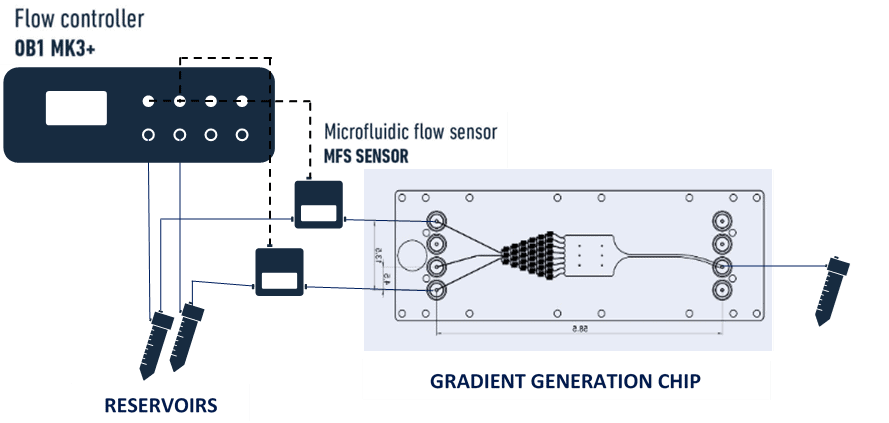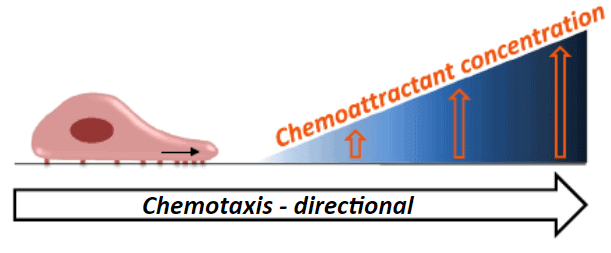Principle figure adapted from Jeon et al. (2002)
MICROFLUIDIC CHEMOTAXIS ASSAY PACK
Unbox, set up and start your experiments right away
Chemical gradient control, reduced reagent consumption, quantification
Laminar flows in straight microchannels limit greatly any mixing
Microfluidic chemotaxis assay
A standard microfluidic chemotaxis pack contains two pumping channels to push the two chemical solutions needed to create the chemical gradient required to observe the chemotaxis of the studied entity.
This gradient is created in a large channel thanks to a network of junctions and serpentines. The pyramidal layout of the chip allows the two fluids to split and mix. The stability and the ratio between the two liquids directly depend on the flow rates of each fluid in the microfluidic channel.
Flow rates can be measured and regulated thanks to the multiple flow rate sensors (MFS or BFS series, Elveflow).
Microfluidic chemotaxis assay enables reasonable gradient control and particle quantification with a good throughput.
Microfluidic chemotaxis assay setup
An all-in-one pack guarantees a good compatibility between the different instruments, allows you to start your experiment right away, is piloted by a single software and can be used for other different applications. These are a few arguments why a pack is the easiest way to setup a microfluidic experiment.

A typical pack contains:
- OB1 flow controller (Elveflow)
- 2x flow sensor MFS (or BFS flow sensor) (Elveflow)
- 2 x 15 mL falcon reservoirs
- Microfluidic chip from microfluidic ChipShop
- All necessary accessories: tubing, connectors, filters, etc…
- Command and automation software (Elveflow)
Why use microfluidic for chemotaxis?
The microfluidic chemotaxis assay pack includes all the microfluidic parts (instruments and microchannels) for you to study the chemotaxis from several different entities like HUVECs or neutrophils faster than with more standard methods.
Based on the high-accuracy OB1 flow controller (Elveflow) and gradient chips, this solution reduces reagent consumption and allows quantification. Our experts will help you set up and use the microfluidic platform step-by-step, thus allowing scientists with no prior microfluidic experience to perform chemotaxis assays.
Firstly, using microfluidics is a way to decrease the amount of potentially valuable samples needed for a reaction, reducing the costs of experiments. Microfluidic chips could also help better mimic the in vivo chemical gradient conditions, thus helping recreate more precise cell chemotaxis in vitro.
Microfluidics make static gradients more stable on long-term scales thanks to laminar flow.
Other microfluidic chips can be easily added before or after the gradient generation chip for chemotaxis assay to create a more integrated platform to perform more complex experiments.
Furthermore, the low sample volume required for experimenting with microfluidics brings more specific advantages, like measuring mouse neutrophil chemotaxis without sacrificing the animal.

1. Ratajczak, M.Z., Suszynska, M. and Kucia, M. (2016), Does it make sense to target one tumor cell chemotactic factor or its receptor when several chemotactic axes are involved in metastasis of the same cancer? Clin Trans Med, 5: e28.
Microfluidic chemotaxis assay principle
It has been showed that microfluidic technology can be particularly useful for the formation of a chemical gradient that allows a good study of chemotaxis [1-2]. The gradient microfluidic chip is able to create a steady state with a stable concentration of chemicals on each point of the channel. This is thanks to the low-Reynolds flows at the microfluidic scale where the diffusion and therefore, the mixing, is limited in straight channels.
The fluids adopt a laminar flow in these kinds of channels. Consequently, we have to first use serpentine channels to make a premixing that allows the formation of the gradient [3].
Microfluidic devices are more effective for chemotaxis assays than more conventional transwell assays for several reasons like reduced reagent consumption, particle tracking and its unmatchable control of the chemical environment [4-7].
Microfluidic device gradient assay allows the study of many cells and microorganisms for multiple potential applications like body function study or developing new treatments [8-9] .
References
- Tanvir Ahmed, Thomas S. Shimizu, Roman Stocker, Microfluidics for bacterial chemotaxis, Integrative Biology, Volume 2, Issue 11-12, November 2010, Pages 604–629
- Li Jeon, N., Baskaran, H., Dertinger, S. et al. Neutrophil chemotaxis in linear and complex gradients of interleukin-8 formed in a microfabricated device. Nat Biotechnol 20, 826–830 (2002).
- Wu J, Hillier C, Komenda P, Lobato de Faria R, Levin D, Zhang M, et al. (2015) A Microfluidic Platform for Evaluating Neutrophil Chemotaxis Induced by Sputum from COPD Patients. PLoS ONE 10(5)
- Wu, J., Kumar-Kanojia, A., Hombach-Klonisch, S., Klonisch, T., & Lin, F. (2018). A radial microfluidic platform for higher throughput chemotaxis studies with individual gradient control. Lab on a Chip.
- R. Keller, Cell migration during gastrulation, Curr. Opin. Cell Biol., 2005, 17, 533–541.
- H. Yamaguchi, J. Wyckoff and J. Condeelis, Cell migration in tumors, Curr. Opin. Cell Biol., 2005, 17, 559–564.
- Wu J, Wu X, Lin F, Recent developments in microfluidics-based chemotaxis studies, Lab Chip, 2013,13, 2484-2499
- Karbalaei, A.; Cho, H.J. Microfluidic Devices Developed for and Inspired by Thermotaxis and Chemotaxis. Micromachines 2018, 9, 149.
- Sackmann, E. K., Berthier, E., Young, E. W., Shelef, M. A., Wernimont, S. A., Huttenlocher, A., & Beebe, D. J. (2012). Microfluidic kit-on-a-lid: a versatile platform for neutrophil chemotaxis assays. Blood, 120(14), e45–e53.
Customize your pack
The gradient chip provided by Microfluidics ChipShop is available in Cyclic Olefin Copolymer (Topas COC) or polystyrene (PS) materials; the material can also be hydrophilized to improve cell seeding. It is easier to seed the cells via the outlet of the gradient chip so they won’t get stuck in the serpentine parts of the channel.
Additional pumping channels for the OB1 flow control pump and flow rate sensors can be added.
Coriolis flow sensors can be chosen to replace the MFS to improve the flow control even more.
Bubbles can be a problem when mixing; we can provide you with a bubble remover that can tackle this issue if it is critical for your experiment.
You can contact our experts for any questions about this chemotaxis assay Pack and how it can match your specifications.
– Check our other Packs for various applications –